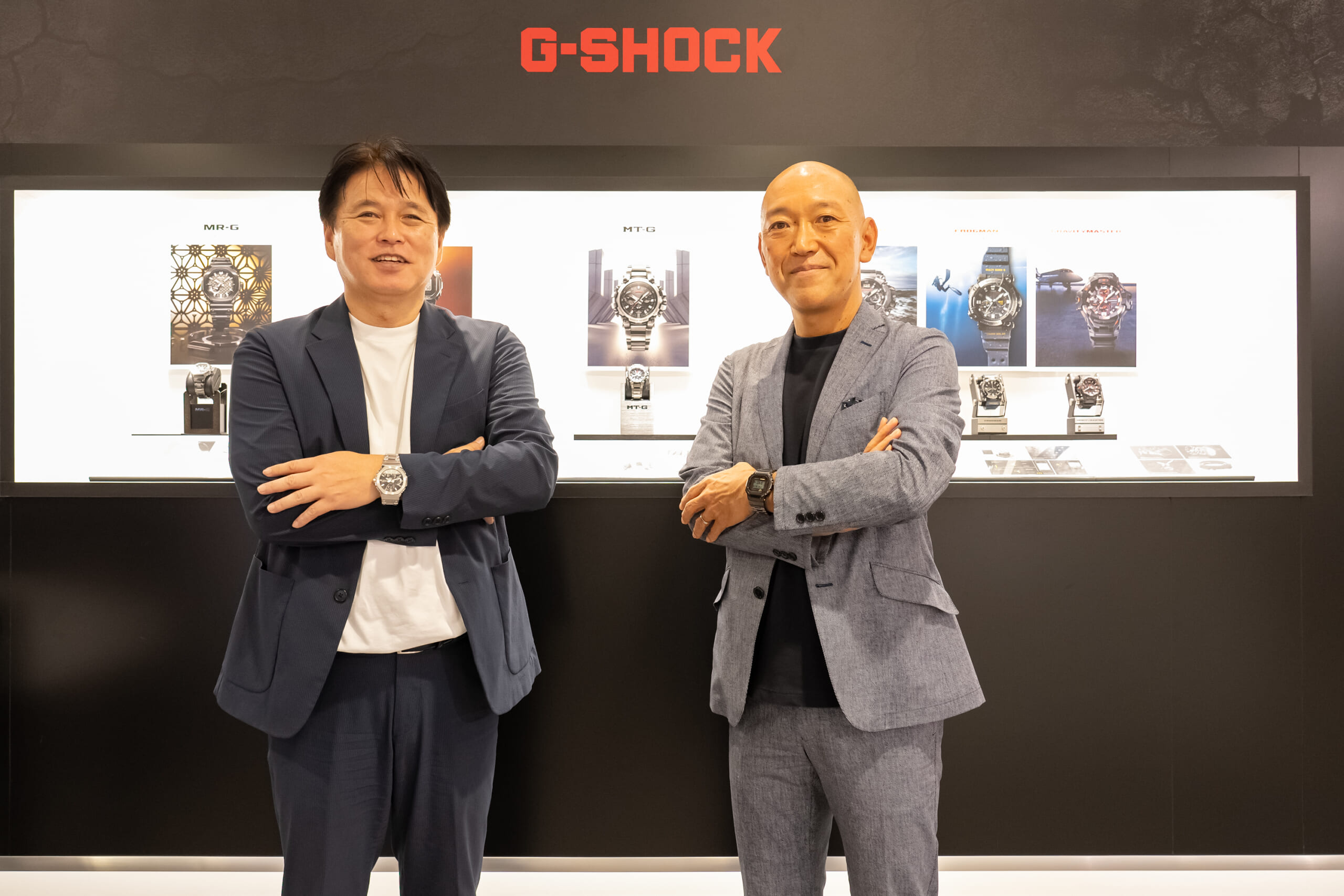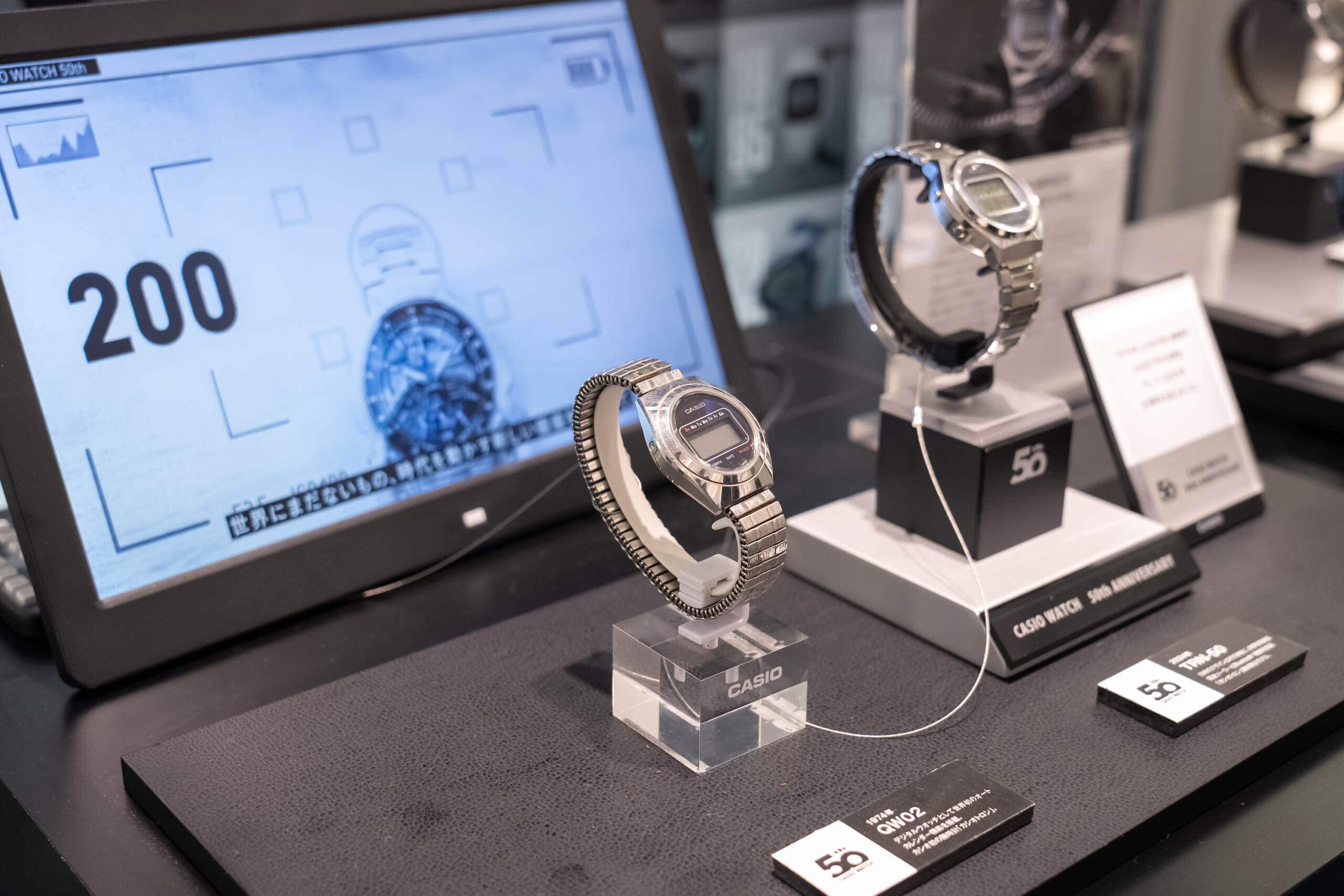
A watch that wouldn’t break even if dropped —this concept ultimately evolved into the globally acclaimed G-SHOCK brand.

Taku Uema and Tadashi Shibuya
Casio Computer Co., Ltd. Sales Headquarters
Over 40 years ago, in 1981, the story of G-SHOCK began with a single phrase written in a project plan: “A durable watch that won’t break even if dropped.” The developer, Mr. Kikuo Ibe, is known worldwide by fans as the “Father of G-SHOCK”. After nearly two years of trial and error, the first G-SHOCK model, DW-5000C, launched in stores on April 12, 1983. In the late 1990s, a massive G-SHOCK craze swept through Japan, but as the boom subsided, the brand faced a period of stagnation. To recapture its essence of “shock resistance (toughness),” G-SHOCK underwent a transformation, rebranding itself as a “cool” global brand through strategic global marketing. Today, the brand boasts a diverse fan base ranging from teenagers to individuals in their 60s, and aims to grow as a lifestyle brand. This case study delves into how a small product born in Japan rose to become a world-renowned brand, uncovering its strategies and secrets.
Chapter.01 From the Beginning: A Company Driven by Zero-to-One Innovation, Expanding Overseas with Original Products
the name of the universally recognizable Cassiopeia constellation, a symbol of cutting-edge innovation. Over the years, Casio has introduced numerous industry-first and world-first products. “Casio has embraced a zero-to-one mindset from the very beginning. We create new markets with the products we develop,” says Mr. Uema, an expert who has led G-SHOCK marketing for several years and possesses an in-depth understanding of the brand’s history.
The first G-SHOCK, launched in 1983, was designed with the concept of “a watch that won’t break even if dropped.” While it initially didn’t garner much attention, its practicality—dubbed “toughness”—was highly valued in the U.S., especially among police officers, firefighters, and military personnel. “Casio established a New York office in 1970. Back then, G-SHOCKs were considered affordable watches, readily available at major supermarkets, and perceived as a budget-friendly brand,” notes Mr. Shibuya, who spent 14 years in the U.S. managing local marketing efforts. “Until 1990, G-SHOCK was largely seen as a durable tool with heavy-duty features,” he adds.
The first turning point came around 1991, when skateboarders on the U.S. West Coast began to appreciate G-SHOCK for its resilience and unique design. This growing popularity eventually made its way back to Japan, sparking a massive wave that peaked in 1997. Limited-edition releases drew long lines of eager customers, turning G-SHOCK into a nationwide phenomenon. Reflecting on this era, Mr. Uema remarks, “This success was a turning point in connecting G-SHOCK with fashion, sports, art, and music cultures.”


Chapter.02 Transforming into a “Cool” Brand through Music, Sports, Fashion, and Art
The post-boom period marked a significant downturn in shipments, but it also became a time to redefine G-SHOCK’s value. The company first returned to its roots by revisiting the essence of G-SHOCK: “unbreakable, unstoppable, and accurate.” This included innovations like solar-powered, radio-controlled technology and the development of “Triple G Resist” toughness which withstands shock, centrifugal force, and vibration—achievements made between 2003 and 2005.
In the U.S., G-SHOCK faced a unique challenge: it was still seen as an inexpensive product available in supermarkets rather than a fashionable accessory. Mr. Shibuya sought to reposition G-SHOCK as a “cool brand” through various reforms, including a major overhaul of distribution channels to focus on department stores and specialty shops. At the same time, the brand expanded into colorful designs, such as white and red models, to appeal to the fashion market. Supporting this effort were prominent hip-hop artists who privately used and featured G-SHOCK watches in their music videos. “When I saw that, I thought, ‘This is it!’ It was a game-changer,” says Mr. Shibuya.
To further establish G-SHOCK as a global brand, Mr. Uema launched the “SHOCK THE WORLD” campaign in 2008, commemorating G-SHOCK’s 25th anniversary. The inaugural event in New York featured a two-part program: a conference showcasing G-SHOCK’s technological background and history for media and retail partners, followed by a party with live performances from major artists. The event’s success led to similar events in London, Paris, Shanghai, Hong Kong, Bangkok, Jakarta and other cities, solidifying G-SHOCK’s image as a global phenomenon. As a result, annual shipments exceeded 10 million units in 2019, surpassing the 6 million units sold at the peak of the 1997 boom.


Chapter.03 Continuity and Alignment: Sharing Japan’s Craftsmanship Story
What is the key to G-SHOCK’s marketing as a global brand? “Consistency is vital and maintaining relationships with loyal fans while continuously appealing to younger generations is critical,” says Mr. Uema. G-SHOCK’s uniqueness lies in its connection to culture—music, sports, fashion, and art—alongside its toughness. “Staying true to these roots while offering new value in line with the times is the secret of G-SHOCK’s strength,” adds Mr. Shibuya.
Recent initiatives include the high-end “MR-G” collection which highlights Japanese craftsmanship, collaboration models with popular anime and pet themes targeting younger generations.” These efforts aim to showcase “Made in Japan” excellence globally while rediscovering and promoting Japan’s appeal.
Mr. Uema also emphasizes the importance of aligning strategies across regions. “G-SHOCK has a genuine story and history. While approaches may vary depending on the country or region, the core values of the brand remain unchanged. This alignment is what we mean by ‘aligning vectors.’ The SHOCK THE WORLD events play a crucial role in this process.”
In 2023, marking G-SHOCK’s 40th anniversary, the brand strengthened its influencer marketing efforts by using global ambassadors and local micro-influencers to deepen engagement and expand awareness.


A brand reflects the quality and trustworthiness of its products and services. “Casio employees must first love G-SHOCK. To keep the brand fresh, we must always challenge ourselves to explore new fields,” says Mr. Uema. “Equally important thing is sharing the brand’s value with local media and retail partners, turning them into fans who believe in our story.”
G-SHOCK has grown to include over 5,000 models and 150 million units sold across 140 countries. Its aspirations now extend beyond watches to becoming a “lifestyle brand.” With its ethos of “G-SHOCK is a companion that shares your challenges,” the brand is embarking on a new journey to create a future beyond timepieces.
Written by: Takahiro Miura
Interview Date: Oct. 18, 2024
The content of this article is as of the interview date.























